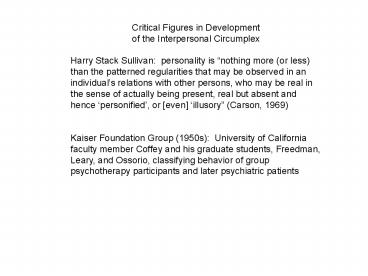Critical Figures in Development - PowerPoint PPT Presentation
1 / 9
Title:
Critical Figures in Development
Description:
Harry Stack Sullivan: personality is 'nothing more (or less) than the patterned ... recapitulation: continue in a complementary way to the IPIR ... – PowerPoint PPT presentation
Number of Views:82
Avg rating:3.0/5.0
Title: Critical Figures in Development
1
Critical Figures in Development of the
Interpersonal Circumplex Harry Stack Sullivan
personality is nothing more (or less) than the
patterned regularities that may be observed in an
individuals relations with other persons, who
may be real in the sense of actually being
present, real but absent and hence personified,
or even illusory (Carson, 1969) Kaiser
Foundation Group (1950s) University of
California faculty member Coffey and his graduate
students, Freedman, Leary, and Ossorio,
classifying behavior of group psychotherapy
participants and later psychiatric patients
2
(No Transcript)
3
(No Transcript)
4
(No Transcript)
5
- Principles of Interpersonal Theory
- Complementarity. Within the circumplex,
interpersonal interactions fit when there is
reciprocity (vertical) and correspondence
(horizontal). Complementary interactions are not
necessarily healthy, but they satisfy peoples
needs for interactions that fit their
self-definitions and interpersonal habits. - Extremity. Abnormal or disordered behavior is an
exaggeration of normal, adaptive behavior. - Interpersonal habits are thought to come from
IPIR (Important People or their Internal
Representations) through copy processes - identification do unto others as has been done
unto you - recapitulation continue in a complementary way
to the IPIR - introjection do unto others as you would have
done unto you
6
(No Transcript)
7
(No Transcript)
8
Equivalent trait and resource terms
Dominance/power Agency Status Extraversion
Affiliation Communion Love Agreeableness
9
Resource exchange theory
S Status and Love O Love
S Status and Love O Neither
S Status and Love O Status and Love
S Status O Neither
S Love O Status and Love
S Neither O Neither
S Neither O Status and Love
S Neither O Status































